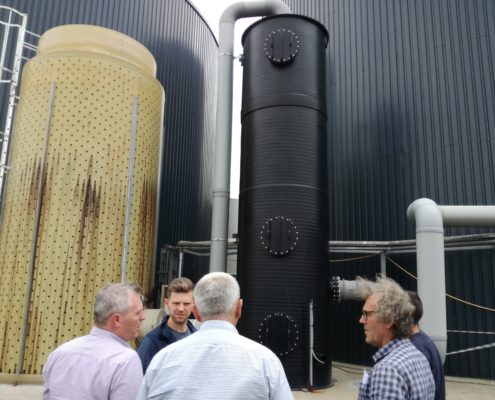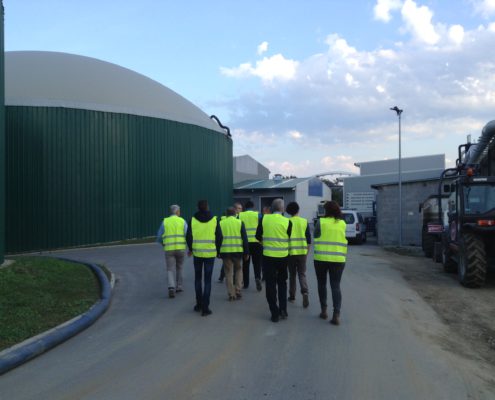Outreach Location Biogas Bree visits Waterleau New Energy and AM-Power
Characterisation of problems and pressure at Biogas Bree
– BB produces a lot of OBW digestate (43.000 tonnes/year)
– Pressure on local market of OBW digestate from
Biogas plants in West-Flanders to storage (and land) in South-Limburg, Brabant
The Netherlands (near the border)
Other large biogas plants in the neighbourhood
This situation can be maintainable for a year or two but will probably also change when fertilisation limits in the Netherlands will become more strict.
– High quality products render the digestate very viscous! ~viscosity cattle manure
Makes separation suboptimal +current cost for chemicals is too high and this influences the business case
Vision of BB for creating better marketable products
Extra storage capacity (9000 m³) to bridge winter period
Get a LF of digestate with composition (3/1/4)= 180N/65P2O5/270K per ha or lower but same ratio and less volume
Scenario 1
Current ratio is more or less good so just remove the water in LF digestate to reduce the volume.
| + | – |
| less storage and transport costs | higher NPK content still favourable for customers even when a higher price is offered? |
| Use this profit to offer the contractors and arable farmers for taking the LF of the digestate. The higher prices offered, will create more potential customers. | short term solution (e.g. pressure from competition and legislation will still be there or get worse) |
| no investments in extra technologies needed | no persevering nutrient recycling and local marketing (circular economy? |
| because of smaller volume, the LF of digestate can be marketed further away | End product of evaporator is a stream of ammonia water. This needs to be marketed. |
Scenario 2
P content of LF dig should be 60% lower than current content LF dig:
P has to be removed
–>improve P separation efficiency of the centrifuge by means of the right amount and choice of chemicals and polymer
P is limiting factor for land application, so if desired ratio is (3/1/4),
the efficiency of the P-separation determines the amount of N that needs to be removed
N content of LF dig should be 50% lower, than current content LF dig:
N has to be removed
–>Ammonia stripper/scrubber
K content of LF dig is OK
Reduction of the volume and concentration of all nutrients
The volume can be reduced by own evaporator, heat is already available
or look at evaporation system?
Evaporation of the water will concentrate K but also P and N!
So P and N in LF should twice as much removed to compensate for this
Balance profit from volume reduction and K content with cost of more intensive P2O5 and N removal!
| + | – |
| valuable end product with NPK 3/1/4: attractive product for arable farmers in the region: less transport costs | Problem is that the digestate is very viscous and would require a lot of chemicals to have an efficient separation of the P. Find the cheapest way to do get P as low as possible |
| If successful: a more efficient P-separation with(out) chemical and/or polymer use | solid fraction of digestate that needs to be dried/blended and marketed |
| Smaller volumes LF digestate can be marketed outside the region: create more marketing opportunities | investment + operational costs for N stripper/scrubber |
| Circular and sustainable for the future (e.g. anticipating on stricter fertilizing limits) | BB is no fan of an ammonia stripper with packing material because of viscosity of LF digestate. Stripper/scrubber should not have a high maintenance cost or time. Own design with sprayers? |
| More independent of the competition (e.g. other biogas plants with digestate to get rid of) | Ammonium nitrate or ammonium sulphate stream needs to be marketed |
| Possible to use parts of technology cascade on a part of the LF of the digestate to create different end products and mix them as desired (customized fertilizers) | The evaporator is now used for reducing the water from the raw pig manure. Contamination issues rising when OBW LF digestate is also used in this evaporator:
Need for separate evaporators |
Other scenario’s for solving this problem?
Choice of technique cascade will depend on what end products the costumers want: Ratio (3/1/4), small or large volumes, low P, organic matter, cheap prices,…?
Learnings from visits to Waterleau New Energy and AM-Power (July 2018)
Invest in an evaporator and/or and ammonia stripper/scrubber to lower the volume and N content of the liquid fraction of OBW digestate?
BB thought that a vacuum evaporator would not be a good option for them because of the high investment cost and the fact that an extra product is created (an NPK concentrate) that has to be disposed of.
The technical and financial feasibility of this idea still has to be researched very carefully.
WNE’s evaporator (atmospheric) is heated with steam. Biogas Bree sees the potential of producing steam, but then also has to consider the investment in a steam boiler (±100.000€ per motor) and this should be balanced with the profits of producing better marketable end products and transporting less water.
Find a way to improve their current separation of OBW digestate with the centrifuge at a low cost.
WNE uses additives (polymers) to improve the separation efficiency. They have good experiences with some suppliers of polymers but emphasize that they come with a high cost.
BB want to avoid using polymers, because creating a polymer solution from powder polymer demands the use of ±20% water per m3 of digestate, which creates extra volume to get rid of in the end.
WNE has good experiences with mixing molasses (more viscous feedstock) with fibre rich feedstocks, or even manure (that maybe have lower biogas potential). They are convinced that it is very important to control the dry matter content up front. If it is higher than 10%DM it will cause difficulties in pumping. Their advice is to find ways to reduce the organic fraction, because this will determine the viscosity much more than the salt content.
Nonetheless, it is difficult to put some input streams on hold if they present themselves. For this you need enough storage capacity or very good relationships with your suppliers.
Since their main focus is producing biogas, at first BB was not interested in using the combination of inputs as a setscrew for controlling the properties of the digestate. After hearing the experiences of AMPower and WNE, BB realized that the quality of digestate can have a huge impact the efficacy of the processing/treatment techniques and therefore cannot be underestimated.
The difficulty is to balance the feedstocks based on biogas potential, mass-and hydraulic balance (which contributes to viscosity of the digestate and the post treatment) and marketing/disposal of end products.
Improve the drying system where they now dry the animal digestate (e.g. digestate from manure).
AMPower has good experiences with their fluidized bed dryer and WNE prefers their disk-dryer.
Future plans and learnings from visits
BB found the visits very useful and has had open conversations with both AMPower and Waterleau, but came back with even more questions.
Their current business case at their location seems to be not so problematic after all and they have faith in the technologies they have implemented now.
Nonetheless, they strongly believe that working towards an end product that can be easier and cheaper disposed of, can make them better prepared for the future -e.g. stricter fertilizer limits, environmental control, financial security, etc.
The (long term) costs and benefits of implementing nutrient recovery or offering a higher price for disposal of their current product have to be carefully analysed and calculated, before considering an investment in new technologies.
- BB will continue to learn from SYSTEMIC but will do their own research simultaneously.
- A new employee (recently graduated engineer) will start in summer 2018 and would be doing research on all previously mentioned ideas and scenarios.
- BB will start investigating the influence of certain feedstocks on the viscosity of their digestate. Maybe Biogas Bree’s case can be involved in the PhD of Claudio Brienza from UGent, doing his research about the relation of parametrs in the feedstocks on the separation efficiency of the digestate.





